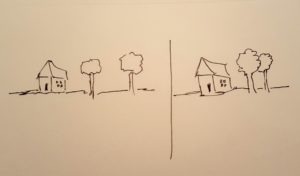One of the most difficult challenges that I have faced in my journey into painting is breaking the bond between my subject as a ‘snapshot’ and my painting as a rendering of what I want to portray. I ruin lots of paintings in a host of ways, but right near the top is an addiction to trying to paint what I see and not what is necessary to achieve a good composition. My advice, if you are just starting out, is remember as an artist you are a magician, not a camera.
Because all painting is essentially abstract in the sense that we take a three dimensional subject and reduce it to a two dimensional format, there are tricks and techniques to bring interest, excitement, movement, energy, and more to a painting. It is not only the fact that we are reducing the reality of our three dimensional world to a flat canvas or piece of watercolor paper, but we may also want to bring greater emphasis to an aspect of our subject or improve the balance of the two dimensional image. The struggle that I refer to in the title of this blog is separating the exactness of what we may see in our subject and employing our artistic license to make the message of what we see, not exactly what we see, the core of our design.
For example, let’s say we have a farm scene….a couple of trees and a farm house. In the simple example below let’s assume the sketch on the left is what actually exists…a house and 2 trees. The problem is, the equally spaced objects in the picture make it static and less interesting. Now, my struggle has been to take the leap…MOVE THE TREE, EVEN IF IN REALITY IT ISN’T ACTUALLY WHERE I PLAN TO PUT IT IN THE PAINTING. The little sketch on the right might be a solution. By moving one of the trees behind the other we improve our composition on several fronts; we do not have all of our shapes equally placed on the frame, we have different sizes and by overlapping these shapes we imply depth. All of these are benefits, but do not occur in the real scene. I have learned that this type of ‘license’ is a very important step in getting a good picture at the end. If your scene does not compose well, you must adjust it.

It is a simple message, and I have read it over and over again. Nevertheless, if you are like me at all, you will really have to work to abandon the sense that a good picture is exactly what you are seeing, when often it is more about what you are feeling and you need to employ the tricks of the trade to bring that to the painting.
If you are asking what those tricks are…there are many. As I am relatively new to the world of art, I know only some, but from time to time I hope to blog about my favorites. Meanwhile, the bookstore or local library is full of books on the subject. I only suggest the sooner you begin to make a picture rather than ‘take a picture’ you should experience better results. I sure have!